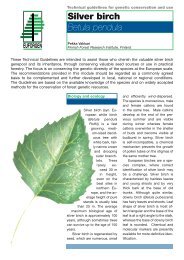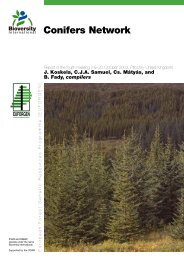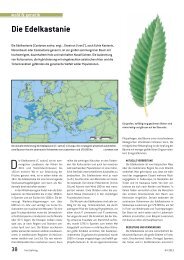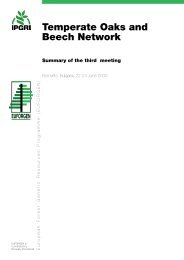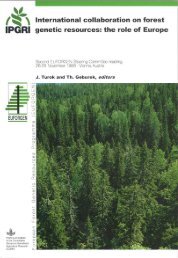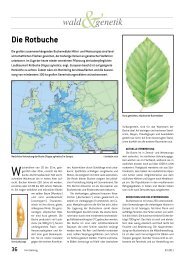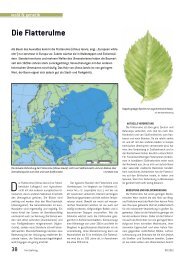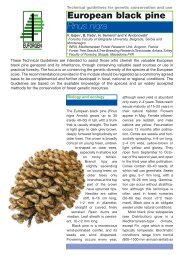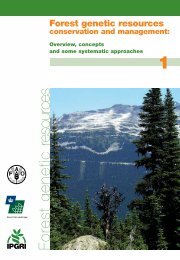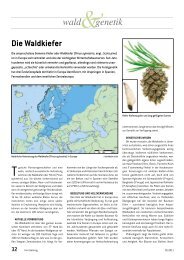Download PDF - Euforgen
Download PDF - Euforgen
Download PDF - Euforgen
Create successful ePaper yourself
Turn your PDF publications into a flip-book with our unique Google optimized e-Paper software.
16 EUEORGEN: Quercus suberNEtWORKNumber of plantsm.t./provenance per plot: 4m.t./provenance per site: 8Provenance/ site: 8 x 20= 160Total number of plants/block:Site (2 blocks): 5440(20 x 4 x 29)= (5 x 80)= 2720AcreageInitial spacing: 5 x 1.5 mInitial number of plants/ha: 1334Plant: 7.5 m"Plot: 30 m ZBlock: 20 400 m 2 = 2.04 haSite: (2 blocks)= 4.08 haFinal spacing: 5 x 6 mPlant: 30 m 2Number of plants/site: 334 x 4.08 ha= 1360Acreage/trial (if 3 blocks)::= 6.12 haTotal number of plants for final evaluation/provenance/trial: 40Total number of plants for final evaluation/m.t./trial: 23.3 General note on the design of the trials (by G. Eriksson)The design of the field trials aiming at study of geneti,c variation within andbetween populations of Q. suber depends on the objectives and the statisticalconsiderations.As to the objectives, it is clearly of interest to obtain information on the variationamong populations. In my opinion, for economically important tree species, as corkoak is in Mediterranean countries, there should be more information on the geneticvariation within populations as well. There have been limited breeding efforts eventhough Q. suber is of great economic importance for at least some of the representedcountries. The field trials could thus also be converted into seed production units inthe future. This adds another objective to a total of three pertinent objectives:• study of genetic variation among populations• study of genetic variation both among and within populations• study of genetic variation and breeding.Objective 1 is best fulfilled by establishment of a classical provenance test.Objective 2 may be carried out as a combined provenance and within-provenancestudy. Each open-pollinated progeny must be represented by at least 24 trees at the'age of evaluation. The problem arises when there are many populations, eachrepresented by a relatively large number of progenies. In the project there are asmany as 34 populations and, for most of them, single-tree progenies are available.Even if all populations were not represented by all 20 progenies, a combinedwithin- and among-population study would not be feasible for practical reasons.The question then arises whether the number of progenies per tree at each site canbe reduced, as suggested in the above proposal (by H. Muhs; see section 3.2). Thatproposal is based on the idea to pool information obtained from all test 'sites fOJstudying the variation within populations. This would be a problem if there was (strong genotype x environment interaction. We do not have any information on th'G x E interaction for quantitative traits. However, results of the studies of geI1etiinformation at isozyme loci (see presentation by R. Lumaret, this volume) show th



